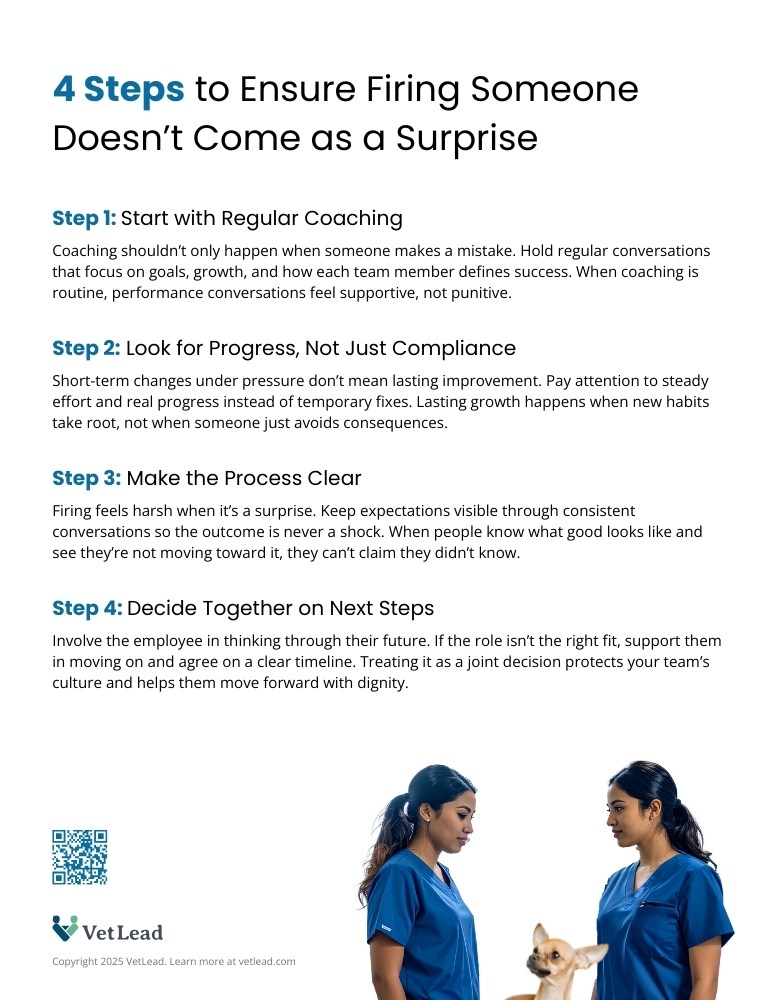I asked a room full of veterinary practice managers a simple question: How many of you have someone on your team you know shouldn’t be there? Almost every hand went up. Then I asked how many had kept that person for over a year. Most hands stayed raised. Over five years? Several hands were still in the air. Finally, one person admitted it had been twenty-two years before they let someone go. Twenty-two years of knowing it wasn’t working, yet keeping that person anyway.
If we’re honest, this isn’t rare in veterinary practices. We wait too long. We avoid the discomfort. We convince ourselves that keeping the wrong person is better than an empty role. But the reality is this: keeping someone who isn’t engaged, productive, or happy isn’t good for them, the team, or the practice. And firing doesn’t have to feel cruel or abrupt; it should never come as a surprise.
4 Steps to Ensure Firing Someone Doesn’t Come as a Surprise
So how do you handle firing in a way that feels fair, consistent, and not like a shock to anyone? Think of it as a process. Here are four steps you can follow to make sure firing is never a surprise in your veterinary practice.
Step 1: Start with Coaching
Coaching isn’t just for when people make mistakes; It should be a regular part of how you lead your team. Every employee deserves coaching conversations, including talk about their goals, their picture of success, and how to move toward it.
Remember, coaching isn’t about punishment. It’s about growth. Ask questions like: What do you want to learn? What do you want to get better at? Where do you see yourself contributing more in this practice? Then, connect their answers to clear expectations and support them in making progress.
When people know you’re invested in their development, they feel supported. If challenges come up, the groundwork is already in place for honest, constructive conversations.
Step 2: Look for Progress, Not Just Compliance

In many practices, we confuse short-term compliance with real improvement. An employee shows up late repeatedly. You confront them, and for a few weeks, they’re on time. But soon, they slip back into old habits.
That’s not growth. It’s fear-driven compliance. What you should look for is steady progress and consistent effort. Are they putting in daily work to improve? Are they trying new habits? Are they moving closer to the expectations you’ve set together?
As a leader, your job is to track effort and progress, not just outcomes. If someone is genuinely trying, even if they’re not perfect yet, you can keep supporting them. But if they’re not putting in the effort - or only changing temporarily to avoid consequences - you’ll know it’s time to move to the next step.
Step 3: Make the Process Clear
Firing feels harsh when it blindsides people. Too often, employees are let go without ever being coached effectively, or without being told what good looks like in their role..
You can make the path clear. Regular conversations should leave no doubt about where things stand. When you say, Let’s meet tomorrow to talk about next steps, it shouldn’t be a shock. It should feel like the natural conclusion of a process that’s already been unfolding.
When handled this way, firing isn’t a threat or an ultimatum. It’s simply the logical next step when improvement hasn’t happened, and that clarity is fair to the individual and to the team.
Step 4: Decide Together on Next Steps
At its best, firing feels less like being kicked out and more like a mutual decision to move on when you and the employee both see that the role isn’t the right fit. When they’re not happy and the team isn’t thriving, it’s time for a change.
This doesn’t mean you hand them the choice of staying or going. It means you involve them in thinking through their future. You might ask, Is this role really what you want? Is this the environment where you can be your best? If the answer is no, support them in transitioning to something better. Sometimes that means giving them time to interview elsewhere or helping them leave with dignity.
But be clear about timing. An open-ended departure only makes things harder. Work together to set a reasonable end date, then support them until that time. You’re helping them take ownership of their future instead of leaving them stuck.

5 Drivers to Build a Fully Engaged Veterinary Team
Download this free resource, share it with leaders and teams. No email address required.
Address It Before It Drags On
The hardest situation you can find yourself in as a veterinary leader is having the same tough conversation over and over again for years. If you wouldn’t rehire someone tomorrow, don’t wait another year to start the process. Begin coaching, set clear expectations, track effort and progress. And if needed, move toward a fair and predictable exit.
Firing should never be a surprise. Done well, it’s the natural outcome of a clear, supportive process. And that process doesn’t just protect your practice: it helps every team member, even the ones who move on, find a future where they can be happier and more successful.
What do you think? Other veterinary pros want to hear from you! Share your experience in the comments below.